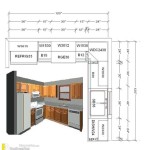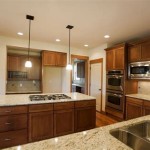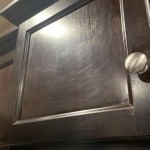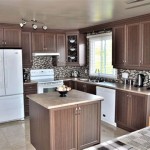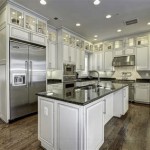What Color To Paint Kitchen With Dark Oak Cabinets
Selecting the correct paint color for a kitchen featuring dark oak cabinets involves careful consideration of the existing wood tones, the amount of natural light available, and the desired aesthetic. Dark oak cabinets inherently possess warmth and depth, characteristics which significantly influence the overall ambiance of the kitchen. A poorly chosen paint color can either clash with these existing elements, resulting in a visually jarring space, or it can inadvertently darken the kitchen, making it feel smaller and less inviting. Therefore, a methodical approach to color selection is paramount, taking into account various factors to achieve a harmonious and visually appealing kitchen environment.
The impact of dark oak cabinets on the kitchen's overall brightness cannot be overstated. Dark wood absorbs light, and consequently, a kitchen dominated by dark oak cabinetry may require a strategic approach to maximize light reflection. Choosing a paint color that complements the wood tone and enhances the available light can significantly improve the space's visual appeal and functionality. Understanding the principles of color theory and how different colors interact with light is crucial for making an informed decision.
Beyond simply selecting a pleasant color, the chosen paint should also work to balance the visual weight of the dark oak. Lighter paint colors can offset the heaviness of the darker wood, creating a sense of spaciousness and airiness. Conversely, opting for a dark or overly saturated paint color can exacerbate the already dark tones, leading to a gloomy and uninviting kitchen. The undertones present in both the oak and the chosen paint color must also be considered to ensure a cohesive and harmonious design.
Understanding Undertones in Oak and Paint Colors
Undertones are the subtle colors beneath the surface hue. Dark oak cabinets often exhibit undertones of yellow, orange, or even red. Identifying the dominant undertone in the oak is the first crucial step. This involves examining the cabinets in various lighting conditions, both natural and artificial, to discern the subtle nuances in the wood's color. Once identified, the paint color selection process should prioritize colors that either complement or neutralize these undertones, depending on the desired effect.
For example, if the oak cabinets have strong yellow undertones, a paint color with cool undertones, such as a pale blue or a soft gray, can help to balance the warmth of the wood. This creates a sense of contrast and prevents the kitchen from feeling overwhelmingly yellow or orange. Alternatively, if a warmer aesthetic is preferred, paint colors with similar warm undertones, such as a creamy off-white or a light beige, can be chosen to create a cohesive and inviting space. However, care should be taken to avoid matching the undertones exactly, as this can result in a monotonous and visually uninteresting kitchen.
Paint colors also possess undertones that can significantly impact the overall visual effect. A seemingly neutral gray paint, for instance, can have undertones of blue, green, or even purple. These undertones become more apparent when the paint is applied to a larger surface and viewed in different lighting conditions. To avoid unexpected results, it is recommended to test paint samples on a small area of the wall and observe how the color appears at different times of the day. This allows for a more accurate assessment of the paint's undertones and ensures that the chosen color complements the oak cabinets effectively.
Moreover, the fixed elements in the kitchen, such as countertops, flooring, and backsplash, should also be considered when selecting a paint color. The chosen paint should harmonize with these elements to create a cohesive and visually appealing design. Coordinating the undertones of all the fixed elements is essential for achieving a balanced and harmonious kitchen environment. Neglecting to consider these elements can result in a disjointed and unappealing space.
Optimal Light Reflectance Value (LRV) for Kitchens with Dark Oak
Light Reflectance Value (LRV) is a measurement of the percentage of light a color reflects. It ranges from 0 to 100, with 0 representing absolute black (absorbing all light) and 100 representing pure white (reflecting all light). In kitchens with dark oak cabinets, the LRV of the paint color plays a crucial role in determining the overall brightness and ambiance of the space.
Given that dark oak absorbs light, it is generally advisable to choose paint colors with a high LRV to maximize light reflection and create a brighter and more inviting kitchen. Colors with an LRV of 60 or higher are typically recommended for kitchens with limited natural light or dark cabinetry. These colors will help to bounce light around the room, making it feel more spacious and airy. Examples of suitable colors include off-whites, light grays, pale blues, and soft greens.
However, the amount of natural light available in the kitchen should also be considered. If the kitchen receives an abundance of natural light, it may be possible to use paint colors with a slightly lower LRV without making the space feel too dark. In such cases, mid-tone colors, such as greiges or muted blues, can be used to create a more sophisticated and nuanced look. It is important to note that even in well-lit kitchens, choosing a paint color that is too dark can still make the space feel smaller and less inviting.
Furthermore, the LRV of the paint color should be considered in relation to the other elements in the kitchen, such as countertops and flooring. If the countertops and flooring are also dark, it may be necessary to choose a paint color with a higher LRV to compensate for the overall lack of light reflection. Conversely, if the countertops and flooring are light-colored, it may be possible to use a paint color with a slightly lower LRV without sacrificing brightness.
Ultimately, the ideal LRV for a kitchen with dark oak cabinets will depend on a variety of factors, including the amount of natural light, the size of the kitchen, and the desired aesthetic. It is recommended to experiment with different paint samples and observe how they appear in different lighting conditions to determine the optimal LRV for the space.
Color Palette Suggestions for Dark Oak Cabinetry
Several color palettes complement dark oak cabinets. These palettes range from neutral and understated to bold and vibrant, catering to a variety of design preferences. The key is to select a palette that creates a harmonious balance between the warmth of the oak and the desired aesthetic of the kitchen.
Neutral Palettes:
Neutral palettes offer a timeless and classic approach to kitchen design. Off-whites, creams, and light grays are excellent choices for creating a bright and airy space. These colors provide a subtle contrast to the dark oak cabinets, preventing the kitchen from feeling too heavy or dark. Consider using warm off-whites to complement the warm undertones of the oak, or opt for cool grays to balance the warmth and create a more modern feel. Accents of natural materials, such as wood or stone, can be incorporated to enhance the overall aesthetic.Cool Palettes:
Cool palettes, featuring blues, greens, and purples, can create a refreshing and calming atmosphere in the kitchen. Light blues and greens are particularly effective at balancing the warmth of the dark oak cabinets and creating a sense of spaciousness. These colors evoke a sense of nature and tranquility, making them ideal for creating a relaxing and inviting kitchen environment. Consider using soft shades of blue or green to avoid overwhelming the space. Accents of white or silver can be incorporated to enhance the cool tones.Warm Palettes:
Warm palettes, featuring yellows, oranges, and reds, can create a cozy and inviting atmosphere in the kitchen. However, caution should be exercised when using warm colors with dark oak cabinets, as they can potentially exacerbate the warmth of the wood and make the space feel overly warm or even overwhelming. If a warm palette is desired, it is recommended to use muted shades of yellow, orange, or red, and to balance them with cooler accents, such as white or gray. This will help to prevent the kitchen from feeling too saturated or visually heavy.Accent Colors:
Regardless of the overall palette chosen, accent colors can be used effectively to add visual interest and personality to the kitchen. Bold colors, such as navy blue, emerald green, or even a pop of red, can be incorporated through accessories, such as dish towels, artwork, or small appliances. These pops of color can help to break up the monotony of the neutral tones and create a more dynamic and engaging space.Ultimately, the best color palette for a kitchen with dark oak cabinets will depend on individual preferences and the desired aesthetic. Experimenting with different color combinations and considering the factors discussed above will help to ensure a successful and visually appealing kitchen design.

Paint Colors For Kitchens With Dark Wood Cabinets Cherry Kitchen

Paint Colors That Go With Oak Cabinets Julie Blanner

Best Paint Colors For Kitchens With Dark Cabinets Jenna Kate At Home

Paint Colors That Go With Oak Cabinets Julie Blanner

14 Amazing Color Schemes For Kitchens With Dark Cabinets

The Best Paint Colors For A Kitchen With Dark Cabinets

Paint Colors That Go With Oak Cabinets Julie Blanner

Kitchen Paint Colors With Dark Cabinets Wow 1 Day Painting

Painted Wood Cabinets Vs Stained A Questionnaire Kylie M Interiors

Will A Dark Color Scheme Work For Your Kitchen
Related Posts

